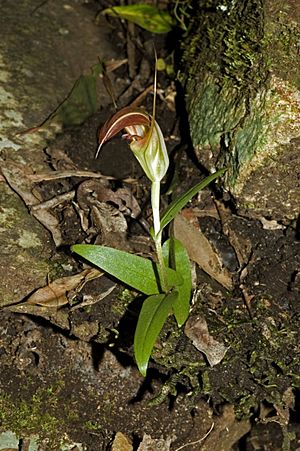Waterfall greenhood facts for kids
Quick facts for kids Waterfall greenhood |
|
|---|---|
 |
|
| Conservation status | |
| Scientific classification | |
| Genus: |
Pterostylis
|
| Species: |
pulchella
|
| Synonyms | |
|
Diplodium pulchellum (Messmer) D.L.Jones & M.A.Clem. |
|
The waterfall greenhood (Pterostylis pulchella) is a special type of orchid that only grows in New South Wales, Australia. It's also known as the escarpment greenhood or pretty greenhood. Like other greenhood orchids, this plant looks different depending on whether it's flowering or not. When it's not flowering, it has a group of leaves that lie flat on the ground. But when it's ready to bloom, it grows a single flower on a stem, with leaves along the stem. This orchid has a reddish-brown flower with a greenish-white bottom part. It also has a special lip-like part called a labellum that sticks out and has a split tip.
Contents
What Does the Waterfall Greenhood Look Like?
The waterfall greenhood is a plant that grows from an underground tuber, which is like a small storage root. It's a perennial plant, meaning it lives for more than two years. It's also deciduous, so some parts might die back in certain seasons.
When the plant is not flowering, it has a group of three to five egg-shaped leaves. These leaves lie flat on the ground and are about 10 to 25 millimeters (0.4 to 1 inch) long. They are also about 6 to 15 millimeters (0.2 to 0.6 inches) wide.
When it's time to flower, the plant grows a single flower on a stem. This stem can be 60 to 150 millimeters (2.4 to 5.9 inches) tall. The flower itself is about 25 to 35 millimeters (1.0 to 1.4 inches) long and 15 to 18 millimeters (0.6 to 0.7 inches) wide. It usually leans a little bit forward. The flowers are greenish-white near the bottom and reddish-brown higher up.
The top part of the flower, called the dorsal sepal, and the petals are joined together. They form a hood, which is also called a "galea," over the central part of the flower, known as the column. The dorsal sepal has a thin, thread-like tip that is 5 to 12 millimeters (0.2 to 0.5 inches) long. The two side sepals, called lateral sepals, are joined near their base. They partly close the front of the flower and have upright, thread-like tips that are 30 to 35 millimeters (1.2 to 1.4 inches) long.
The labellum, which is the special lip of the orchid, is 16 to 18 millimeters (0.6 to 0.7 inches) long and about 4 millimeters (0.2 inches) wide. It's curved and dark reddish-brown, sticking out above the opening of the flower. You can usually see these beautiful flowers from February to May.
How Did It Get Its Name?
The waterfall greenhood was first officially described in 1933. A scientist named Pearl Messmer found a sample of the plant near Fitzroy Falls, New South Wales. She wrote about it in a scientific paper called Proceedings of the Linnean Society of New South Wales.
The scientific name pulchella comes from a Latin word. It's a smaller version of the word pulcher, which means "pretty." So, pulchella means "pretty little." This is why it's also sometimes called the "pretty greenhood."
Where Does This Orchid Live?
The waterfall greenhood is quite particular about where it lives! It likes to grow on cliffs close to waterfalls. You can also find it on damp, sheltered ridges and on mossy rocks near small streams.
This special orchid is only found in five specific places. All of these locations are along the Illawarra escarpment and in the Southern Highlands region of New South Wales.
Why Is This Orchid Special? (And How We Protect It)
The waterfall greenhood is considered a "vulnerable" species. This means it's at risk of disappearing if we don't protect it. It's listed as vulnerable under two important Australian laws: the Australian Government's Environment Protection and Biodiversity Conservation Act 1999 and New South Wales' Threatened Species Protection Act 1995. These laws help protect plants and animals that are in danger.
The biggest threat to the waterfall greenhood is that people sometimes illegally collect them from the wild. Taking these plants is against the law because it harms their populations and makes it harder for them to survive. Protecting their natural homes and making sure people don't take them are important steps to help this beautiful orchid thrive.


